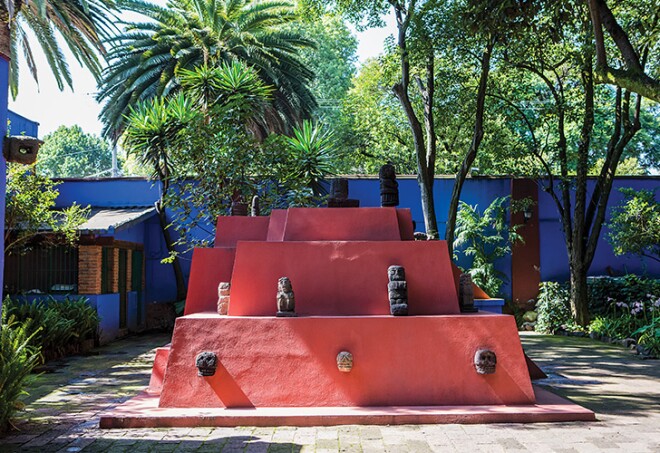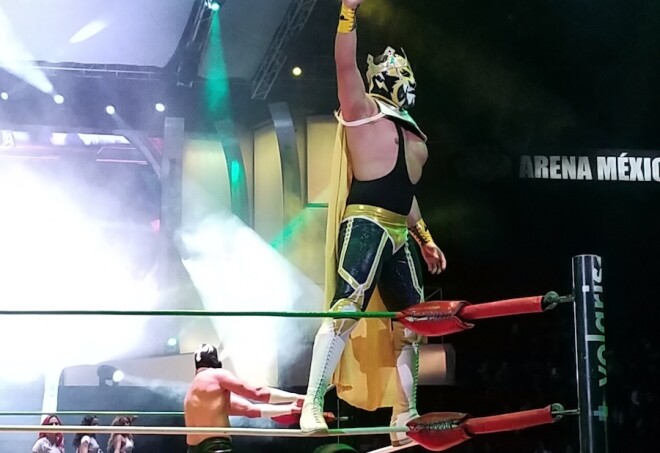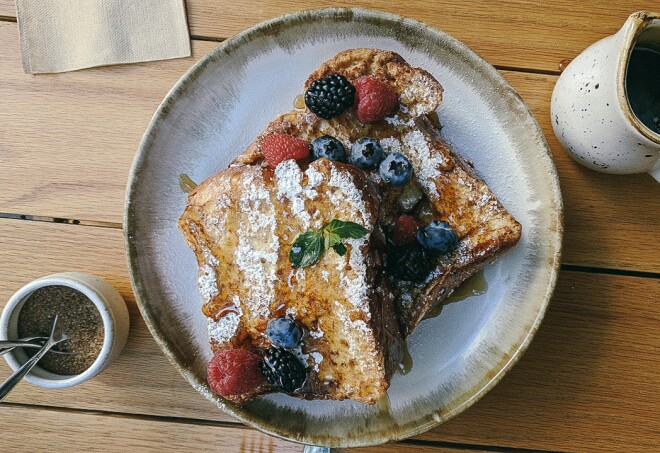The Perfect Weekend in Mexico City
Tour the street-food scene, haggle your way through a craft market, visit the ancient city of Teotihuacan, and don’t miss the spectacular Zócalo flag ceremony with goose-stepping military police (the weightier the ceremony, the higher the kick!). Three days gives you just enough time to learn why you’ll want to come back to vibrant Mexico City.
Plaza de la Constitución, Centro Histórico de la Cdad. de México, Centro, 06000 Ciudad de México, CDMX, Mexico
Its massive size, centrality to daily life in the capital, and easy accessibility (a Metro station opens up right onto the plaza) makes the Zócalo an ideal place for large-scale temporary exhibits. The government hosts occasional exhibits and makes entry free for residents and visitors alike. Past exhibits have included Gregory Colbert’s “Ashes and Snow,” a show of large-format photos of animals and people, and Willy Souza’s “Mexico en tus sentidos” (“Mexico in your senses”), lush, vivid photos of people and places around Mexico. To see if a show is planned during the time you’ll be visiting, check the website of the Secretary of Tourism.
S/N, Balderas, Colonia Centro, Centro, 06040 Ciudad de México, CDMX, Mexico
Most travelers can’t resist a bargain, but for some visitors, the real pleasure of shopping comes in haggling expertly to secure a lower price for the object of their desire. If that sounds like you, then head to La Ciudadela or any of the other craft markets in Mexico City, and practice your bargaining skills... in Spanish. Can you negotiate a lower price for those vasos marked 6 for 120 pesos? How about the blouse that’s marked 200 pesos or the hand-beaded mask that’s officially priced at 500 pesos? See if your Spanish skills pay off—literally—by saving you money during your market excursions.
Acceso a la Piramide del Sol por puerta 4
While it’s not in Mexico City proper, the sacred pre-Hispanic city of Teotihuacan is close enough–about 30 miles– for an easy day trip if you’re interested in architecture, archaeology, and indigenous history. The site’s primary structures, the Temple of Quetzalcoatl and the Pyramids of the Sun and the Moon, have been designated by UNESCO as World Heritage Sites, and it is possible to explore the pyramids–and even climb them–either independently or with a guide. After ascending nearly 250 steps on the Pyramid of the Sun, you’ll have a greater appreciation for these ancient structures and the civilization responsible for having built them. In addition to the pyramids, an on-site museum documents the history of the so-called “City of the Gods,” and displays archaeological finds, including pottery, bones, and other important objects.
Calle Ernesto Pugibet, Colonia Centro, Centro, 06000 Ciudad de México, CDMX, Mexico
You may not know it, but as you peruse the stalls of vendors at Mercado San Juan, you just might be rubbing shoulders or vying for the plumpest, prettiest chayote with one of Mexico City‘s top chefs. San Juan is the market for serious home cooks and pro chefs alike. Here, you can find everything from just-off-the-boat fish and seafood to wild game. There have even been rumors over the years (urban legend or fact?) that if you know who to ask, you can procure true exotics here, including tiger and bear meats. If you’re not in the market for any goods to go, you can let your nose lead the way to a stall where prepared hot foods are sold. And don’t miss trying chapulines, toasted grasshoppers, which are a Mexican snack specialty.
Av. Juárez S/N, Centro Histórico de la Cdad. de México, Centro, Cuauhtémoc, 06050 Ciudad de México, CDMX, Mexico
The imposing, white-domed wedding cake now known as Palacio de Bellas Artes was originally planned as a national theater, and construction was begun in 1904. The Mexican Revolution, among other things, postponed its completion until 1934, which explains the stark contrast between its creamy art nouveau exterior (note amazing iron- and stonework with local motifs like serpents) and its art-deco-inspired interior, finished in black and red marbles, and with walls that feature dazzling murals by Rivera, Siqueiros, and other postrevolutionary masters. Today the beloved edifice is home to a concert hall, exhibition areas given over to blockbuster shows, and Mexico’s National Architecture Museum; take an auditorium tour—or better yet, see a performance—to lay eyes on the theater’s magnificent Tiffany glass “curtain,” a mosaic formed (they say) by more than 1 million separate glass components.
Seminario 8, Centro Histórico, Cuauhtémoc, 06060 Ciudad de México, CDMX, Mexico
With the Spanish conquest of the Aztec empire, Iberian overlords set about imposing their customs on the subdued populace, eliminating traces of pre-Hispanic religions they deemed heretical by demolishing major temples and building churches and other structures atop their ruins. Centuries later, in 1978, workers laying electrical lines happened upon the remains of the Templo Mayor, the Aztecs’ most important ceremonial center (and, yes, the location of their notorious human sacrifices). Subsequent excavations have revealed superimposed pyramid foundations and priceless artworks, many now displayed at the on-site museum. Thrillingly, treasures keep turning up—including the spring 2017 discovery of a stone box containing some of the finest Aztec gold ever found, just off the Templo Mayor’s steps.
157 Doctor García Diego
If you have time to visit only one of our picks for stellar street art, Foro Cultural MUJAM should be the spot. Its building, and those surrounding it, are wall-to-wall with murals and pieces by both local and international artists. MUJAM, the Museum of the Juguete Antiguo Mexicano (Vintage Mexican Toy), is responsible for having organized the city’s first street art festival in 2007, drawing top names from around the world to collaborate on massive, ambitious street art projects, including many you’ll see in this neighborhood.
Av. Pdte. Masaryk 390, Polanco, Polanco III Secc, 11560 Ciudad de México, CDMX, Mexico
Mexico City has no dearth of luxurious boutique hotels, but Las Alcobas is a special option. Designed by famed firm Yabu Pushelberg, the hotel is full of gorgeous details, from hand-stitched leather wall coverings to a spiral staircase that surges up from the lobby. Upon arrival, guests enjoy a welcome drink as a bellman leads them to their room; explains the technology that controls the light, sound and temperature; and offers them a selection of handmade soaps. Once settled in, they can lounge in plush robes on their goose-down comforters while sampling snacks from the minibar. For a heartier meal, Las Alcobas offers two excellent restaurants. Just outside the hotel’s front door, there’s also Presidente Masaryk, Polanco’s main avenue full of restaurants and high-end boutiques.
Paseo de la Reforma & Calzada Gandhi S/N, Chapultepec Polanco, Miguel Hidalgo, 11560 Ciudad de México, CDMX, Mexico
Housed in a 1964 structure whose modern lines and central fountain greatly complement what’s on view, this anthropology museum is a repository of the most important pre-Hispanic treasures modern Mexico has discovered. The works are displayed in exhibits that trace the entire history of the Americas’ indigenous population, from the Bering migration to the present day. Exhaustive (and sometimes exhausting) in scope, many visitors choose to jump ahead to “greatest-hits” galleries focusing on name brands like the Aztecs (to see their misnamed calendar stone); the Maya and their artifacts; or the Olmec culture, famed for its colossal (and quite sensual) head sculptures dating back to Mesoamerica’s earliest recorded eras.
Lardo, a sister restaurant to chef Elena Reygadas’s Rosetta and her bakery, is especially warm and buzzy on sunny days, when the Condesa restaurant’s full facade of French doors is thrown open and its handsome crowd spills out. The kitchen applies all the chef’s singular refinements to a winning mix of Tuscan recipes that put special focus on fine charcuterie. Menu items are (perhaps deceptively) simple: poached eggs, seasoned variously; a nice selection of pizzas; fresh, vinegary salads that don’t go overboard; grilled shellfish. The complexity arises from their delicacy on the palate, where each crisp taste is savored separately—and as a part of the whole. A nice wine list encourages sobremesa, the delightful Mexican custom of lingering over the table. Breads—either the ones that come with your meal or the ones you take home from the on-site bakery—might be the best in the city.
With almost 20 years at the helm of a dining room that’s jammed every afternoon, Gabriela Cámara at Contramar must be doing something right. For one, the seafood on offer—traditional, even homey recipes, impeccably prepared—is among the freshest available. Service is quick, yet warm and enjoyable. It brings in a well-dressed, deliberately coiffed crowd that loves table-hopping, seeing and being seen, and air-kissing; but most of all, they relish digging into house specialties like the fish carnitas, the legendary tuna tostadas, and the grilled pescado a la talla (ordered by weight, and served in a red adobo or a parsley rub). Some afternoons (especially Fridays) you can’t believe the waiters have actually squeezed one more person in, yet everyone is very glad they came. Desserts are especially recommended. Open for lunch only—which may explain the sense of urgency at the door.
Londres 247, Del Carmen, Coyoacán, 04100 Ciudad de México, CDMX, Mexico
The cobalt-blue-and-brick-red residence where now-legendary Mexican visual artist Frida Kahlo grew up—and at times lived with husband Diego Rivera—is one of the city’s most consistently packed attractions; buying tickets in advance is strongly recommended. That said, the visit is essentially (and justifiably) mandatory and offers fascinating glimpses into this extraordinary woman’s life and work. In addition to holding some of her paintings, the house also functions as a showcase for her library, astounding wardrobe, and collection of pre-Columbian artifacts; it additionally bears witness to her close association with left-wing politics. What’s more, the museum portrays the artist’s struggles with depression, marital infidelities, disability, and illness. The house’s garden—home to a modest café and mostly bashful felines—makes for a great breather before more strolling in the Coyoacán neighborhood.
Anatole France 100, Polanco, Polanco III Secc, 11560 Ciudad de México, CDMX, Mexico
Never underestimate the power of shocking pink. The intimate but lively dining room at Dulce Patria—the smash hit by celebrity chef Martha Ortiz—feels not unlike a stage set. Soon after 2 p.m., it starts to fill with high-powered ladies-who-lunch types, cooing over a menu of updated Mexican classics with extravagant, architectural presentations that are at least half the fun. That said, chef Ortiz’s flavorful sculptures really deliver: Tastes are delicate, authentic, and quite delicious. The well-balanced offering presents ample choices without overwhelming, in favorites like the corn-kernel soup, a full portfolio of quesadillas, duck mole, and an extravagant dessert list (gelatin lovers rejoice) that really does drive home the dulce part. A recent seating included telenovela stars and a former Señor Presidente. And who knew there were so many edible flowers?
Dr. Lavista 189, Doctores, Cuauhtémoc, 06720 Ciudad de México, CDMX, Mexico
The concierge at the hotel was skeptical. The cab driver was amused and skeptical. Lucha libre, or Mexican wrestling, is clearly an unsophisticated embarrassment, tantamount to telling a visitor to the U.S. to watch Keeping Up with the Kardashians. Attending a match, though, is a way to see a side of Mexican culture not found in museums or historic churches, but one that definitely uses some of the same mythology, iconography, and pageantry seen there. The crowd shouts, chants, and laughs through performances featuring dancing girls, inept referees, men in lavish and ridiculous costumes (a caveman with a plastic club, fur boots, and a skimpy loincloth), and some honest-to-God astounding feats of athleticism. Matches—loud and funny and thrilling—take place on Friday nights and occasionally during the week. Tickets can be bought in person at the arena, but arrive early to avoid a long line and use your time to shop the stands set up outside for handmade lucha libre wares (wrestling capes, masks, T-shirts, onesies for infants).
Calle Marsella 72, Juárez, Cuauhtémoc, 06600 Juárez, CDMX, Mexico
Tucked away on a quiet San Miguel Chapultepec street, but just next door to lively Colonia Condesa, this odd restaurant’s yellow façade leads to a culinary experience that goes way beyond the food served. Under the direction of Norma Listman and Saqib Keval, Masala y Maíz is a space of culinary encounter between Mexico and India; entrees often mix pickled fruits and vegetables in Latin American styles. The makai pakka combines Mexican esquites with a similar dish from Kenya. The partner-chefs connect food and current events as well; they commit to a socially responsible work environment and the restaurant serves as a progressive events forum. Open for breakfast and lunch, plus Saturday-only brunch.
Río Nazas 50, Cuauhtémoc, 06500 Ciudad de México, CDMX, Mexico
This tiny café serves up some of Mexico City’s tastiest breakfasts alongside impeccable coffee. A year and a half out from its opening, it was the first place in town to offer Japanese-siphon-extracted brews. They’re also into methods like dipper and French press; choose from Veracruz, Oaxaca or Chiapas varieties, and even take home some beans. Naturally, with the joe at this level, there’s got to be breakfast of equal caliber; the beet hummus (with poached egg) and the berry French toast are current faves. That said, the menu never, ever bores.
Av. Pdte. Masaryk 201, Polanco, Polanco V Secc, 11560 Ciudad de México, CDMX, Mexico
Ultra-modern Hotel Habita sits on upscale avenue Presidente Masaryk, in the midst of the Polanco’s fine restaurants and shops. Opened in 2000 and renovated in 2012, the hotel, which looks like a glass cube, continues to attract travelers who appreciate its sleek design and superb location. Rooms are typical of Grupo Habita hotels-spare and uncluttered, with luxurious toiletries and high-tech amenities, like flat-screen TVs and free Wi-Fi. The staff is accommodating and will help guests with everything from transportation recommendations to securing reservations at top nearby restaurants, such as Biko, Pujol, and Quintonil. All three appeared on the 2015 “Latin America’s 50 Best Restaurants” list.
Hotels
Isabel la Católica 30, Centro Histórico de la Cdad. de México, Centro, 06000 Ciudad de México, CDMX, Mexico
Hands down the best place to stay in Mexico City’s Centro Histórico is the aptly named Downtown. Located inside a restored 17th-century casona (mansion), the hotel shares its property with a select group of Mexican businesses, including a chocolate boutique and a mezcal bar, as well as restaurants, cafes, and fashion and jewelry ateliers. Appropriately, rooms evoke a bygone era, with low lighting, brick ceilings, and tile floors somewhat reminiscent of a monastery. Amenities are spare but select (C.O. Bigelow toiletries, for starters), and service is unobtrusive but attentive. After a day spent exploring the city, head to the rooftop pool and bar, where you can sunbathe on a bright yellow chaise lounge or sit under an oversized umbrella while waiting for your cocktail to arrive.



























